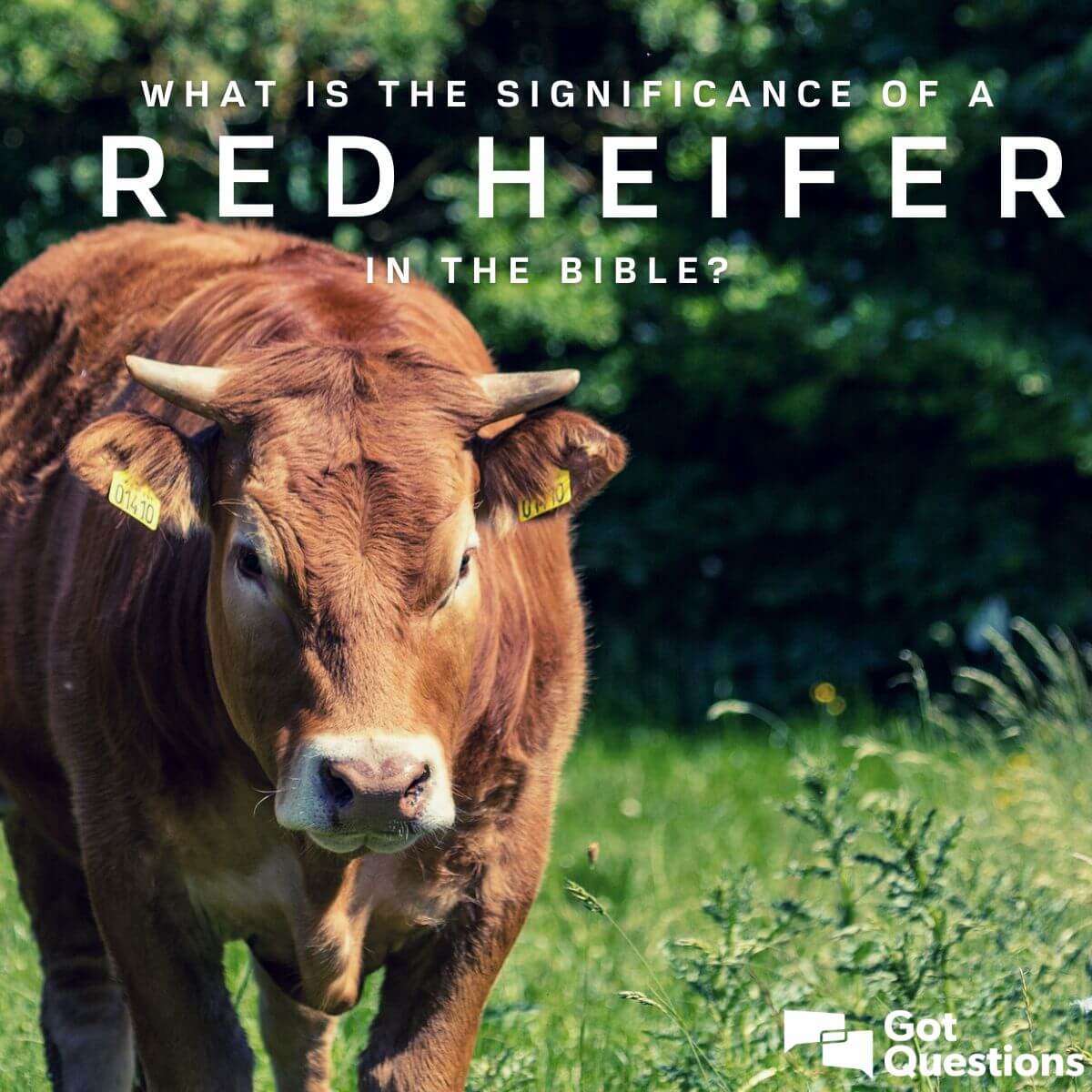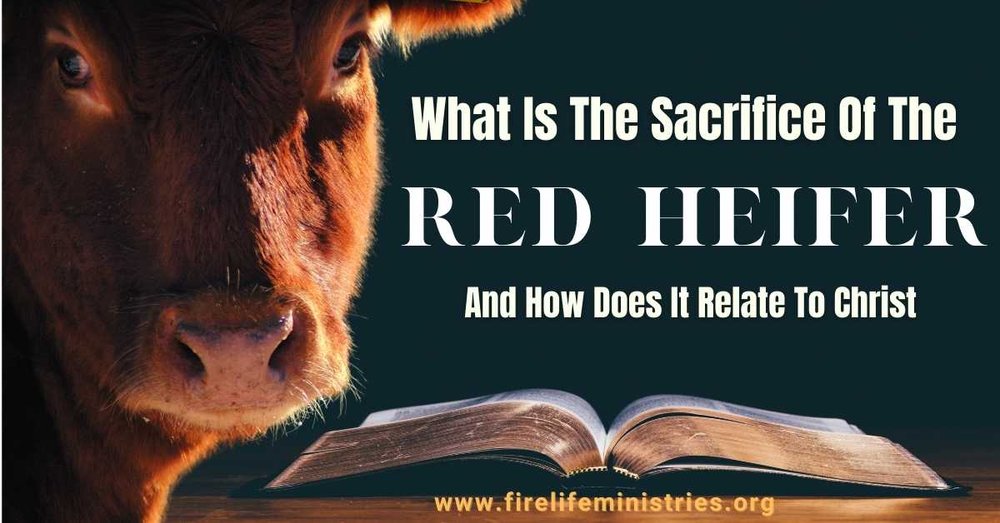Does an ancient ritual involving a red heifer hold the key to understanding biblical prophecy and the potential for future events? The story of the red heifer, a unique and meticulously defined sacrificial offering, is not just a historical curiosity but a profound theological symbol with implications that resonate even today.
The quest to understand the red heifer leads us deep into the heart of the Old Testament, particularly the Book of Numbers, where the practice is described with striking detail. This isn't merely a quaint custom of a bygone era. The ritual of the red heifer, known in Hebrew as Parah Adumah ( ), was a cornerstone of purification rites, designed to cleanse those who had come into contact with death. Its purpose transcended the immediate need for ritual purity, delving into larger questions of sin, atonement, and the covenant between God and his people.
The red heifer's significance lies in its utter uniqueness. The animal had to be a perfect specimen: a spotless red heifer, without any physical defect, and crucially, one that had never borne a yoke. This detail alone highlights the symbolic weight of the ritual. The heifer, untouched by the burdens of labor, was a vessel of purity, sacrificed to restore purity to others. The ashes of the burned heifer were then mixed with water, creating a cleansing solution used to purify those who had been defiled by touching a corpse.
- Trina Net Worth 2024 A Deep Dive Into The Rappers Wealth And Success
- Exploring Ab Quintanillas Net Worth The Musical Genius Behind Selenas Legacy
The following table provides a concise overview of the key aspects of the Red Heifer ritual:
| Aspect | Details |
|---|---|
| Name in Hebrew | Parah Adumah ( ) |
| Biblical Reference | Numbers 19 |
| Purpose | Purification from ritual impurity caused by contact with a corpse. |
| Requirements for the Heifer | Spotless, red, without defect, and never yoked. |
| Process | Slaughtered outside the camp, burned with specific items (cedarwood, hyssop, scarlet wool), ashes mixed with water. |
| Significance of Color | Red symbolizes sin and the blood sacrifice for atonement. |
| Modern Relevance | Connected to discussions about the Third Temple in Jerusalem and end-time prophecies. |
The color red itself carries significant weight within the biblical narrative. It is frequently associated with sin and impurity (Isaiah 1:18), making the red heifer a poignant symbol of both the problem of sin and the provision for atonement. Consider the symbolism of the blood life itself being offered as a means of cleansing. The ashes, then, are a reminder of the ultimate sacrifice, the breaking down of the impure to create the pure.
The procedure itself was a carefully orchestrated event. The heifer was brought to Eleazar the priest, taken outside the camp, and slaughtered. The red heifer was then burned on a pyre. This wasn't a simple bonfire; the burning involved specific ingredients. The Mishnah details that the pyre included wool dyed scarlet, hyssop, and cedarwood, all burned to ashes alongside the heifer. The ritual culminated in mixing the ashes with water to create a purifying solution. Those who had become ritually impure were then sprinkled with this water on the third and seventh days after their contamination.
- Mike Smith Net Worth A Comprehensive Insight Into His Wealth And Career
- Exploring Dr Doug Weiss Net Worth Insights Into His Life Career And Success
Historical accounts, according to the Mishnah, place the ceremony of the sacrifice and burning of the red heifer on the Mount of Olives, outside of Jerusalem. A ritually pure Kohen, a priest, performed the slaughter, sprinkling the blood in the direction of the Temple seven times, further emphasizing the ritual's connection to the sacred space and the ultimate goal of spiritual cleansing.
The red heifer is not simply a historical curiosity. It provides a glimpse into the Israelites' understanding of the connection between the physical and spiritual realms. It highlights the importance of ritual, but it also underlines the concept of grace and atonement. The Israelites sought a way to deal with death and its impurity; the red heifer was the prescribed method.
Beyond its immediate function, the red heifer ritual opens a window into broader theological concepts. The sacrifice offered a temporary cleansing, a reminder of the ongoing human struggle with sin and imperfection. This cleansing, in turn, can be viewed as a prefiguring of a more profound spiritual purification. The use of blood, the life force, for atonement also points to the idea of a more significant, ultimate sacrifice.
The preparation of the red heifer holds a unique place in Jewish tradition. It is mentioned in the Book of Numbers and is also the subject of the final Torah reading on Shabbat Parah, the Sabbath of the red heifer. This places the ritual within the context of sacred texts and practice, and reinforces its significance to Jewish believers.
The number of red heifers prepared throughout history is surprisingly limited. Only nine were prepared before the destruction of the Second Temple, with the last one nearly 2,000 years ago. This scarcity further underscores the unique nature of the ritual and its specific purpose. This scarcity fuels speculation about its role in the future, particularly in relation to the rebuilding of the Third Temple in Jerusalem.
The return of the red heifers has sparked significant debate and speculation, particularly in the context of end-time prophecy. The potential connection between the red heifer ritual and the construction of the Third Temple in Jerusalem has captured the imagination of many, with discussions focusing on the fulfillment of biblical prophecies.
The question of the Third Temple's construction and its place in the prophetic narrative is complex. The Book of Ezekiel describes a future temple, which is one of the key focuses of contemporary discussions. Some believe the red heifer is an essential prerequisite for its construction, since the purification ritual is necessary to ready the area for holy use. The debate encompasses the role of the Messiah, the timing of events, and the interpretation of specific biblical passages.
The red heifer ritual is a reminder of both the severity of sin and the potential for redemption. It emphasizes the need for cleansing and the promise of a fresh start. The color red, often associated with sin, becomes the instrument of purification, a stark representation of the cost of atonement.
In the context of the future, the preparation and sacrifice of the red heifer can be viewed as a signal of transformation. The act of purification and the focus on redemption can be linked to the larger themes of hope and renewal. The careful preparation and unique characteristics of the red heifer serve as an enduring reminder of the importance of faith and ritual, in the search for deeper meaning in human existence.
The interpretation of the red heifer ritual is multifaceted. Some see it as a historical event, a law given to the Israelites to address specific issues of impurity. Others view it as a foreshadowing of greater truths, pointing to a spiritual redemption. The red heifer, while a mystery, provides a framework for understanding sin, forgiveness, and the ongoing human journey towards a relationship with the divine. The significance of the red heifer extends beyond its ritualistic purpose, pointing to the broader theological themes of sacrifice, atonement, and the promise of redemption.
The meaning of the red heifer, then, hinges on the idea that purification leads to transformation, which ultimately brings us closer to redemption. This is the enduring message, a reminder of both the seriousness of our transgressions and the amazing grace that can wash us clean.
The discussions surrounding the red heifer highlight that in the language of the Bible, red isn't limited to what we now define as red. It includes various shades of brown and other similar tones, further contributing to its symbolic significance. The key element is the color's association with sin. The animal's unblemished state and the absence of a yoke reveal that it was offered wholly to God.
For further reading and exploration, consider the following resource:
The Red Heifer - Chabad.org



Detail Author:
- Name : Brenna Cruickshank V
- Username : grant27
- Email : ygreenfelder@hotmail.com
- Birthdate : 1984-06-27
- Address : 708 Ana Extension Apt. 291 Kassulkemouth, NH 39414
- Phone : +1-715-288-3682
- Company : Shanahan-Hackett
- Job : Pest Control Worker
- Bio : Dolore quo ut sit ut rem. Velit beatae magni autem cum libero.
Socials
facebook:
- url : https://facebook.com/willn
- username : willn
- bio : Rerum dolores nesciunt cupiditate unde ut.
- followers : 4637
- following : 2997
twitter:
- url : https://twitter.com/nayeli_official
- username : nayeli_official
- bio : Quis quod placeat tempora sapiente ut illo ut. In et ut aut libero maxime quaerat. Sapiente libero est ut nostrum accusantium. Qui molestias et qui ex officia.
- followers : 5642
- following : 91
instagram:
- url : https://instagram.com/nayeli_will
- username : nayeli_will
- bio : Culpa dicta minus earum. Doloremque ducimus sed sed ut velit perferendis nam delectus.
- followers : 6580
- following : 2116